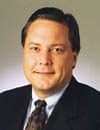Sleep Review interviews John Miclot, president of the home care division at Respironics
 John Miclot, president of the home care division at Respironics, Pittsburgh, shares with Sleep Review the company’s complete treatment plan for patients with sleep disorders.
John Miclot, president of the home care division at Respironics, Pittsburgh, shares with Sleep Review the company’s complete treatment plan for patients with sleep disorders.
Q. What sets Respironics apart from other manufacturers of sleep-related products?
A. We take a disease-management approach toward treating sleep-disordered breathing. We approach the marketplace in conjunction with the physician and home care provider communities and the payors to focus first on the consequences of untreated sleep-disordered breathing. Then we work with the general practitioners, home care providers, and sleep laboratories to build awareness.
Q. Can you explain how Respironics answers the needs of people with sleep disorders?
A. Once we have identified patients with obstructive sleep apnea (OSA), our clinically validated Berlin questionnaire gives a strong indication whether patients are likely to have the disorder. That helps us avoid the cost of a diagnostic test that might not be needed. Then we have a significant program built around both portable and home diagnostics, and we sell polysomnography systems like our Alice® system into the sleep laboratory. After diagnosing these patients, we can identify the nonresponsive or nontolerant patient with our SmartCard™ technology. When the patient originally goes on the REMstar® Pro CPAP system, we look at their utilization as well as their quality of life through the SmartCard. The home care provider or sleep laboratory does not have to send anyone to the home because the card can be mailed. It gives them a full report about how the patient is using or benefiting from the therapy. With our REMstar product line, we would recommend our integrated humidification system for patients who are nonresponsive or nontolerant. From there, we offer our Comfort Series™ masks for patients. If they are still having problems, then we have the BiPAP® rescue program, which moves these patients into bilevel therapy with our new BiFlex™ system. In the end, we have demonstrated significant increases in compliance.
Q. What do you see for the future of the sleep industry?
A. We believe that there are opportunities outside of OSA. Certainly the patients we see today and treat with CPAP are just a portion of those who suffer from sleep-disordered breathing. We have strong evidence that ties sleep-disordered breathing with hypertension and congestive heart failure. We believe there are opportunities to help manage milder OSA patients with dental appliances and other technologies. There are opportunities in the area of insomnia. We recently introduced a product to measure insomniac sleep patterns in the first objective way. It is called REMview™. Today, insomniacs keep sleep diaries, and when we compare a sleep diary with a REMview study that actually monitors their sleep and awake states, we see a significant deviation in what they self-report and what actually occurs. We are also interested in circadian rhythms and are trying to optimize phase-shift disorders through simpler, more efficient light therapy.

